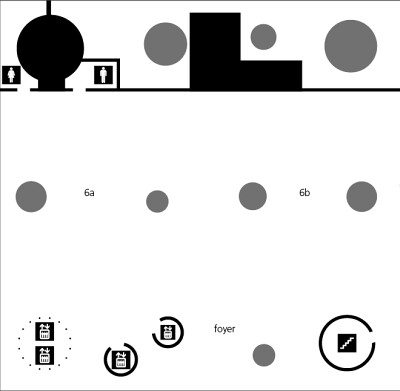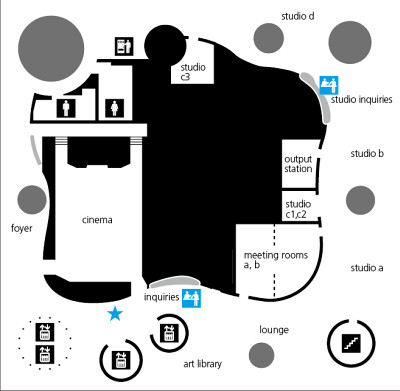William Alsop
The British architect William Alsop
would like to see a project from his office, as for instance The Fourth
Grace in Liverpool, as a “[…] form-less building that appears to be out
of focus and always moving.”3
The work of William Alsop and Erick van Egeraat overlaps
significantly here. The design of William Alsop for the Fourth Grace in
Liverpool resembles the design of Erick van Egeraat for Capital City in
Moscow. In the Netherlands both architects have not by coincidence
designed a pop-podium that looks like a boulder – Erick van Egeraat
designed the Mezz in Breda, William Alsop designed the Muzinq in Almere.
There are of course also lots of differences. William Alsop is a
painter, and he works this attitude out in his architecture in a very
explicit manner, for instance in his articulate coloring. But despite
the differences between them here the overlap in architectural concept
is relevant and informative.
The notion of the ‘formless, out-of-focus’ building of William Alsop
is connected with the ‘soft’ architecture of Erick van Egeraat. In the
eyes of Erick van Egeraat Modernism is too simple and too easy legible.
Baroque buildings are far more interesting, because they are much less
legible, and therefore don’t bore that easily.
Erick van Egeraat - Capital City, Moscow (Copyright EEA)
William Alsop - Fourth Grace, Liverpool
I think that the amount of recoding4, the amount of expression, the
Baroque-ness in the architecture of William Alsop and Erick van Egeraat
makes both architectures not easily legible, and therefore leaves the
spectator puzzling sometime about what they see. The decoration
provides a ‘suspense’, just as film and television leave you wondering,
suspended, about how this film or series will end. And is ‘suspense’
not one of the most powerful emotions that one can experience?
William Alsop and Erick van Egeraat are not alone in their
realization of suspense. The work of modern artists like David
Lachapelle and Jasper Goodall shows the same kind of insistence on the
form-less, the surreal, the decorated, the Baroque.
The work of these Baroque architects and artists find their
conceptual image in the artwork ‘the Manimal.’5 This is a
computer-generated hybrid of a snake, a lion and a human. The multitude
of differences in comparison to a human face and the stratification of
the image of the Manimal produces a ‘suspense’ with the spectator.
Erick van Egeraat: “Often we find things that we don’t understand beautiful.”2
Feminine beauty
Interesting is that the work of Jasper Goodall, David
Lachapelle and Erick van Egeraat also overlaps on an other level. All
three have a fascination for the female (sexual) object and claim that
they make things that in the first place just have to be ‘beautiful.’
The work of Goodall and Lachapelle is explicit erotic. In the work of
Erick van Egeraat feminine beauty plays a more implicit a role. (Erick
van Egeraat’s wife is not by coincidence a model.)
Erick van Egeraat states that you can describe (feminine) beauty in
ideal measurements and proportions. But in reverse it is never true
that if you apply these ideal proportions, a design automatically
becomes beautiful. Just look at the ‘ideal’ women that are generated
with the computer. Apparently beauty is more complex and maybe
imperfections and coincidences are also important.
According to Erick van Egeraat Le Corbusier developed his Modulor so
his associates could no longer mess things up with this
measurement-system. But not a single building by Le Corbusier follows
his system totally. Clearly Le Corbusier knew that beauty doesn’t
emerge from ideal measures.2
The question that arises with the work of Jasper Goodall, David
Lachapelle, and Erick van Egeraat is whether design that is stripped
from every ideology necessarily focuses again on the natural, and in
extension of that on the female (sexual) object. If you strive like
them to a layered beauty that develops itself from a desire, a
suspense, than the desirable female object seems to be the perfect
starting point.
This article has been published in Dutch in the architectural magazine Pantheon// in July 2006.
1. This citation is an excerpt of an interview with Erick van
Egeraat that I did with Barbara Luns in February 2004 and that has been
published in Pantheon//.
2. Egeraat, Erick van; The Value of Beauty, lecture in Bacinol 12 January 2006
3. Jencks, Charles; The Iconic Building, Frances Lincoln, London 2005
4. Raaij, Michiel van, Remix Mies, Pantheon// Projective Landscape, February 2006
5. Berkel, Ben van; Bos, Caroline; Move, UN Studio, Amsterdam 1999
Update 3 march 2007
William Alsop announced
this week that it will built a 43-story appartment-tower in the center
of London. On top of a public plinth 15 stories of self-storage spaces
are hidden behind an artwork of Bruce McLean. More similar to the Avant-Garde project in Moscow of Erick van Egeraat than I could have ever imagined.
I don’t know why the design by Alsop uses so much dark colors, that
way avoiding a contextual relationship with the sky. Maybe architects
should ‘paint’ more on white canvasses when designing towers.

William Alsop - 151 City Road, London





























